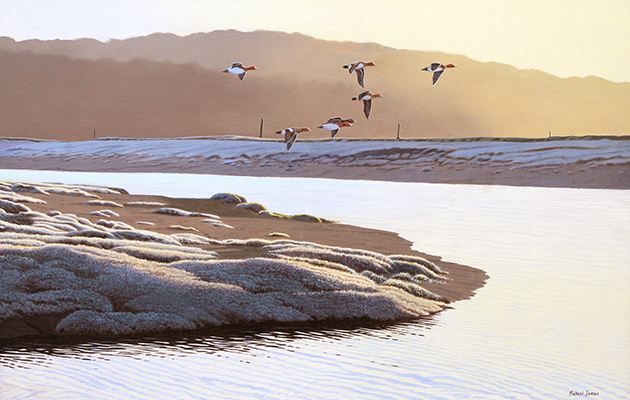Michael Demain tells Janet Menzies how delivering a piano struck a chord, inspiring him to put down his hod and pick up a paint brush
A boyhood spent in the Lancashire countryside made birds of prey and grouse a natural subject for Michael Demain, as he explains to Janet Menzies.
For more sporting artists, Caroline Cook has adapted her art through multiple crises. And Oliver Akers Douglas captures the sporting scene just before it springs to life.
MICHAEL DEMAIN
As far as Michael Demain knew, he wasn’t going to be an artist. He was a hod carrier, which he was good at, and also thoroughly enjoyed. But you can’t carry hods forever, so Demain had a change of career to removals man – or, rather, artist.

Dropping in – Pink-Footed Geese.
He explains: “I was delivering a piano to an address not far from where I lived and I saw some paintings on the wall. I just couldn’t believe that people could paint like that. Even when I went away, I couldn’t get it out of my mind and I just wanted to do it.” The owner of the piano was Lancashire wildlife artist Steven Townsend. “I left the house in a state of near shock and amazement, I had seen in those few minutes my future, although at the time I didn’t know it. For the next two weeks I could not get it out of my mind and eventually I plucked up the courage to return to Steve Townsend’s house. As he opened the door I just blurted out: ‘I want to do what you do.’
“So I painted two paintings; I still have them somewhere. My first effort painting. There must have been something about them for Steve to say: ‘You need to carry on.’ As a lad, I always drew. If the weather was too bad to go out I would spend a lot of time drawing. But I never realised that you could do that. In those days you left school and you got a job; nowadays, it would be different.”

Somewhere secret, a study of a woodcock.
Demain’s boyhood was spent exploring the wild countryside of Bowland in Lancashire: “I could see the Trough of Bowland from my window and I have always lived within 20 miles of it. I have been interested in birds all my life, so I have spent a lot of time looking at them. When I was young, there weren’t peregrines; because of all the insecticides they had become quite rare, but there were always grouse and lots of waders, as there are now.”
So when Demain first discovered painting it was natural for him to turn to birds, especially birds of prey and grouse. His photo-realistic style was instinctive: “Some artists like to paint loose, but I prefer to be detailed – probably because I was influenced by Steve Townsend.”
INDIVIDUAL METHOD
Demain’s method is all his own: “First you have to have a composition. The composition comes about through what you see – when you are out in the countryside you see paintings. The birds and the animals are not necessarily there at that point. I take the photographs of the birds and the scenery separately usually. If I want to paint geese I go out onto the salt marshes. To paint a subject you have to have a knowledge of it, you have to understand your subject. And you need to place them correctly, which only comes from long hours watching them.
“If I want to paint a peregrine I will go out and take lots of photographs with interesting light. It is the light that I love. It is all about light. I won’t go out in the middle of the day or in the summer. Early spring or winter are best for me. The light has to be right, a low light, and the colours are important.”

Looking back – a red deer stag.
Demain also insists: “The birds have to be right, and you do amass a lot of knowledge. I recently sold a painting of grouse in the snow to a client whose gamekeeper had said the grouse are right.”
The photo-realist style felt natural for Demain from the start, but that doesn’t make the work easier. The genre requires huge attention to detail if it is to be executed successfully and Demain admits: “There is pressure, sometimes every brush stroke is a battle. When I am working, it is like climbing a ladder: you want to be at the top but you have to step up there rung by rung. The hardest part is picking up the brush and getting on with it.”
Like most artists, Demain is looking forward to 2021 as a year to get back out on the road. He says: “I love exhibiting at shows like the Exhibition of Wildlife Art, the David Shepherd Wildlife Foundation’s Wildlife Artist of the Year and the Scottish Game Fair, so hopefully all these will be going ahead this year.”
Michael Demain’s work can be seen on his website: michaeldemainwildlifeart.co.uk and at game fairs and art festivals around the country.





